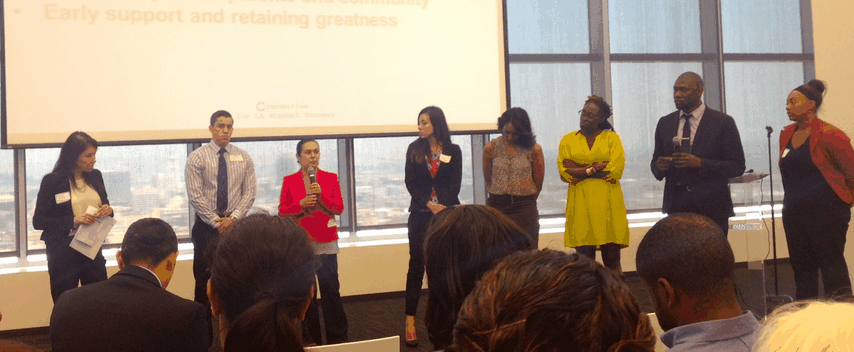Your donation will help us produce journalism like this. Please give today.

Maria Brenes of InnerCity Struggle (in red) and other CLASS members address the audience at yesterday’s kickoff event.
Communities for Los Angeles Student Success (CLASS), a new coalition of eight community groups and education-related organizations, officially debuted on Thursday to resounding cheers and support of about 150 educators and community members at United Way of Los Angeles headquarters downtown.
The large, high windowed-room overlooking all of downtown was filled with education advocates, parent groups, Los Angeles Unified School District (LAUSD) representatives and many other members from different organizations supporting L.A.’s massive school system.
Collectively, CLASS represents 115,000 students, teachers, parents and other community members, and has also cast its net wider than traditional education advocacy groups to include parent groups, health advocates and foster youth organizations
While CLASS is comprised of different sorts of advocacy groups — from InnerCity Struggle to Educators for Excellence — the broad-based coalition shares the same overarching mission: close the achievement gap in LAUSD.
“It’s a civil rights issue,” said Kaci Patterson of Families in Schools. “There are too many students in too many schools who cannot read by the time they leave third grade. Too many students don’t have access to rigorous enough courses to get them into college.”
Between potato salad and cold-cut sandwiches, participants listened as different CLASS members presented the coalition’s three top priorities: lifting up low-performing schools, expanding access to quality teaching and learning and increasing resources, support and safety for students.
One of CLASS’s first steps to developing a plan to fix the second largest school district in the country was to survey over 100 community leaders about the state of LAUSD.
Ama Nyamekye, executive director for Educators 4 Excellence, presented the findings. “Most responders said they wanted to provide school with more local control of decision-making,” said Nyamekye. “They also want a more diverse evaluation system for teachers that includes classroom observations, parent and student input and student growth on tests.”
A more extensive evaluation system for principals was also overwhelmingly desired, as well as more college and career preparation courses for all students.
Over half of those surveyed wanted additional revenue directed to early childhood education.
Chris Turner from the Los Angeles Urban League addressed LAUSD’s lack of representation in Sacramento. “From all the districts in the state, L.A. is the only district who does not have a spokesperson vying for them in Sacramento,” said Turner. “That’s scary to me.”
The presentation ended with a question: “Who wants to join CLASS’s mission in improving equity and access for under-served students in Los Angeles?”
Of course every hand in the room shot up and hundreds of information cards were filled out and handed in with promises of support and action.
But another question, not as easily answered, was also asked. “How?” “Can you give more specifics?” One audience member asked. “Are you working with decision makers in LAUSD?”
Questioned another “What about the schools in youth correctional facilities who aren’t represented by LAUSD? How do we help those students?”
These types of questions as to how exactly CLASS planned to achieve its impressive, overarching goal continued and leaders of the fledgling organization, started about six months ago, did not have specific answers.
“We are starting the conversation on how to build the framework for this group,” said Turner.
Though some attendees asked if CLASS was just another education organization attempting to make sweeping changes in a school district wrapped tightly with red tape and bureaucracy, its members assured its fellow educators that there group was a different story.
“What’s different now is timing,” Nyamekye told the LA School Report. “There is a lot of grassroots energy in L.A. right now. Parents are readily getting involved all over the district and we are harnessing that grassroots power.”
Though representatives from LAUSD hesitated to answer directly if they believed that CLASS would really make a difference, Pedro Salcido, a legislative liaison for the district, said the vast amount of people involved under one name was a positive sign.
“They have a clear set of priorities and one vision,” said Salcido. “Many of these organizations have been around for a while and have come together to do good work.”
“When you get this many people in the same room for one thing, that’s always a powerful thing,” he added.
Members of CLASS were even more optimistic that this coalition was different — and could make a difference.
“We are moving beyond the traditional education space,” said Patterson.
Ryan Smith from United Way agreed. “Including teacher advocacy organizations is a new thing,” he added.
Another difference, he noted, was that CLASS’s goal is to “create policy, not merely respond to it.”
“We’re starting discussions now about different advocacy campaigns to bring more resources to the most underprivileged students,” said Smith.
The energetic launch ended on a high note, with many educators shaking hands, smiling and lingering in small groups.
Getting hundreds of educators in a room is a good thing. An even better thing is if CLASS can turn those conversations into powerful actions. We will wait and see.
Previous posts: Local Groups Join Up for School Improvements; What Do Ed Leaders Want From LA’s Next Mayor?; What Next for the Coalition for School Reform?
